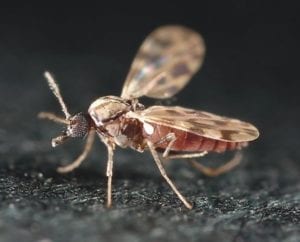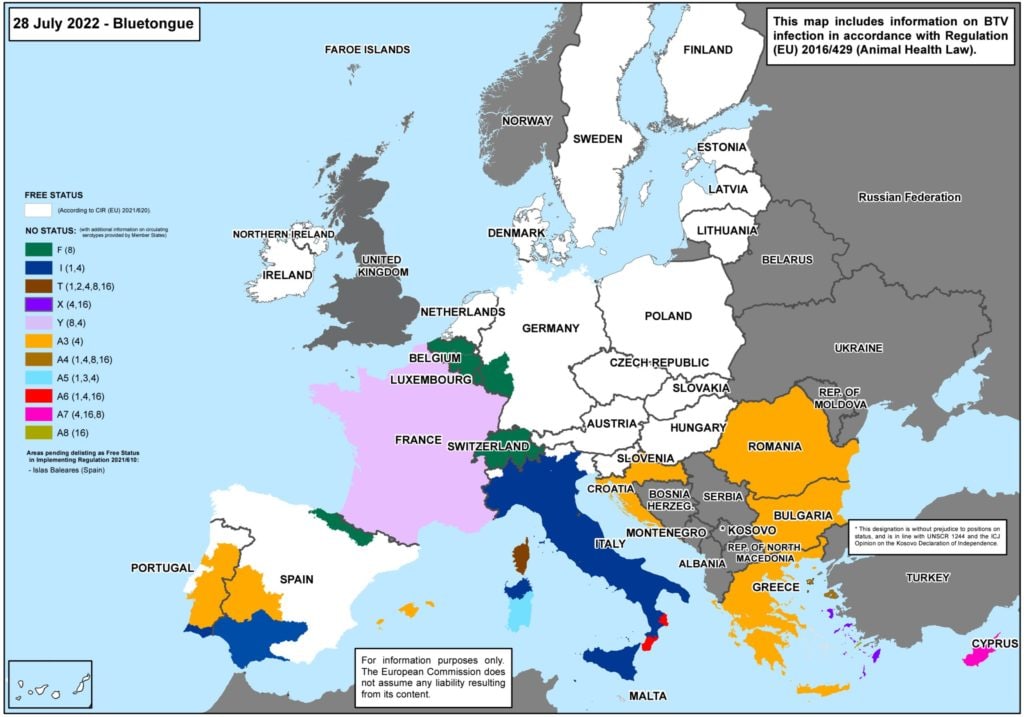



Diagnosis, prevention and control of Bluetongue virus
Is BTV worldwide?New Serotypes Rapidly Evolving and Spreading to New Areas
Bluetongue virus (BTV) is often thought of as a seasonal challenge; however, livestock producers should consider it a serious concern due to the emergence of new BTV serotypes and their ability to spread, evolve, and adapt to new geographical areas.
Bluetongue is an infectious but noncontagious arthropod-borne disease that primarily affects domestic and wild ruminants. It is caused by a complex non-enveloped virus that has a capsid and a double-stranded RNA genome. BTV is considered a rapidly evolving pathogen [1]; there are 29 different serotypes, and the virulence and mortality rate of the different strains vary considerably.
How is BTV Transmitted?
BTV has been identified around the world and is transmitted by the various Culicoides biting midge species that inhabit different regions.

While BTV is transmitted in tropical regions throughout the year, infection is much more likely during periods of warm weather, and most infections occur during the late summer and autumn months. Cattle are the reservoir host for BTV. Midges become infected after feeding on the blood of an infected animal, and then the virus reproduces in the midge until a high titer is reached, enabling transmission to other susceptible animals.
BTV is not transmitted by direct or indirect contact between animals in the absence of the Culicoides vector. However, it can be transmitted in utero from mother to baby. Bluetongue does not affect humans, nor is there any risk of the disease being contracted or spread through meat or milk.
BTV-free countries often prohibit livestock movement from BTV-endemic regions. Because of this, the annual economic damage in lost trade is estimated at $3 billion [2].
BTV is Expanding Around the World
Globally, BTV is currently distributed at latitudes between approximately 53°N and 35°S, which are broadly the tropical and subtropical regions. However, the virus is known to be expanding into the northern hemisphere. In Europe, bluetongue has been confirmed in the Balearic Islands, Sardinia, Sicily, Corsica, and regions of Italy, Spain, France, and Portugal [3]. In recent years the disease has also been detected in the Netherlands, in an area close to the border with Belgium and Germany.
BTV Detection in the European Union
The EU Member States map shows BTV-free countries (as of July 2022) in white (Figure 1). Countries that are not BTV-free are shown in colors that indicate the specific circulating serotypes in that region.

Further Global Distribution
It is generally recognized that BTV is endemic throughout most of South Africa; 22 of the 29 known serotypes have been detected in the region. Novel BTV serotypes have been found in historically enzootic (endemic) countries or regions, including the southeastern United States, Israel, Australia, and South America, indicating diverse pathways of transmission.
How to Identify BTV
Bluetongue gets its name from the vascular damage caused by the virus that results in severe swelling of the tongue. In ruminants, BTV can cause abortions, malformed fetuses, and even death. Other symptoms include inflammation of the mucous membranes, congestion, swelling, and hemorrhage.
Visual Identification and Clinical Signs
Visual identification of BTV infection can be challenging, especially in cattle since the clinical signs are similar to symptoms of other diseases. Often, cattle may become infected and exhibit a high level of viremia that lasts a long time, even while not necessarily showing outward signs of infection. In sheep, more classical clinical signs are identified, including fever, lameness, and edema.
Bluetongue Virus Serotypes Have Different Properties
The clinical signs in animals infected by different BTV serotypes can vary because each serotype has different properties. For example, the BTV-8 strain that was circulating from 2006 to 2009 caused quite high morbidity in both cattle and sheep.
Prevention and Treatment of BTV
There is no treatment available for BTV infection. However, according to The Pirbright Institute, the central difficulty in fighting BTV is that infection or vaccination of an animal with one serotype does not create immunity to any of the other serotypes. Virus protein 2 (VP2), which is located at the surface of the virus, both determines the serotype and activates the host animal’s immune response. Since vaccines exist for only a few of the serotypes, knowing the serotype of BTV that is causing a given outbreak in a herd or flock is key to finding the correct BTV vaccine that will protect your animals [4].
Vaccination and Biosecurity to Mitigate Risk
If a farm is BTV-free, a veterinarian can identify the regional risk and help make an informed decision on whether vaccination makes sense, based on the farm’s business risk and the diagnostic testing results in the region. If BTV has been found in your region or is a seasonal threat, make an appointment with your veterinarian and remain vigilant.
Diagnosing BTV
Real-Time PCR-Based Detection Kit
Infected cattle without clinical signs may be an invisible source of BTV within a herd or region. Many European countries are establishing surveillance and management programs to help veterinarians and farmers battle BTV when it is detected. Some EU countries are working toward disease-free status using eradication programs.
The Applied Biosystems™ VetMAX™ BTV NS3 All Genotypes Kit is a polymerase chain reaction (PCR)-based detection kit that has been validated by the Pirbright Institute, an OIE reference lab for BTV. (The kit was formerly called the LSI VetMAX BlueTongue Virus NS3—All Genotypes Kit.) The VetMAX BTV NS3 kit can quickly and reliably identify if BTV is present and which strain is involved. It serves to specifically detect from one to 27 genotypes of BTV using real-time reverse transcription PCR.
Highly Sensitive, Specific Detection of BTV
Each RNA sample is analyzed in a single well; the same well is used to specifically detect both the viral RNA of BTV and an internal positive control (IPC). A positive IPC signifies both successful extraction and the absence of PCR inhibitors in the sample. The kit can be used on viral RNA extracted from whole blood (in EDTA tubes), spleen, or organs of aborted animals. It does not detect EHDV (epizootic hemorrhagic disease virus), a relative of BTV. This kit enables highly sensitive and specific detection of BTV nucleic acid in animal samples, allowing for reliable and rapid screening and identification of infected animals.
References
- Alkhamis MA et al. (2020) Global emergence and evolutionary dynamics of bluetongue virus. Scientific Reports 10. doi:10.1038/s41598-020-78673-9.
- Rushton J, Lyons N (2016) Economic impact of bluetongue: a review of the effects on production. Veterinaria Italiana 51:401–406. doi: 10.12834/VetIt.646.3183.1.
- Eurpoean Commission (2006) Q&A bluetongue. Press corner. https://ec.europa.eu/commissio....
- The Pirbright Institute (2015) Bluetongue virus. https://www.pirbright.ac.uk/bluetongue.
For Veterinary Use Only. For In Vitro Use Only. Regulatory requirements vary by country; products may not be available in your geographic area.



